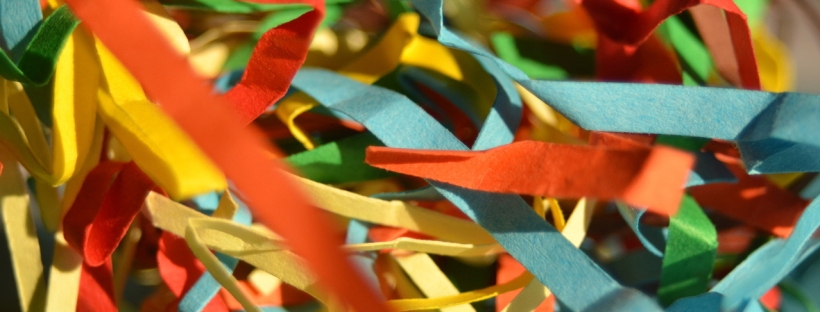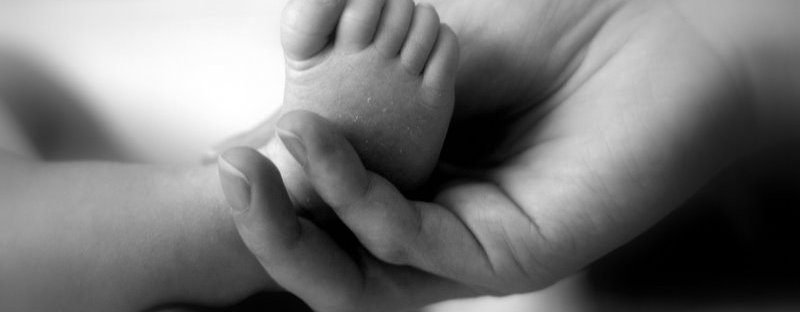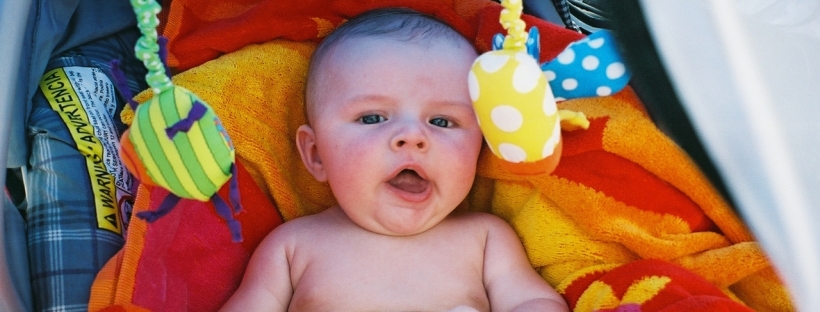Put paper into a shredder if you have one. Otherwise, cut paper into long thin pieces. You can use a variety of paper. For instance, construction paper, printer paper, magazine sheets, scrap paper, or newspaper. Then put it all in a tub where he can play away. He will be transfixed with pulling the paper apart and feeling how it crumples together.
Category: 3-6A
Water Paper Baby Activity
This is a simple activity that captivates little ones. It usually is the simple ones. Grab a tub and fill it with water. Grab different types and sizes of paper and stack it next to the tub. Example paper types: printer paper, scratch paper, notes, magazine pages, or construction paper. Watch as she dips, pushes, and soaks the paper in the water. After awhile of play, you can add a new element by giving her child friendly tongs, spoons, ladels, or cups to poke, scoop and play with the paper.
Power of Touch Baby Activity
In one study, 4 month olds who received an 8 minute massage performed better on early memory and sensory skills tests. Ideas on baby massage:
- Make sure the environment has no additional stimulus in the background (aka TV) and that the temperature of the room is warm and comfortable for him. You ideally want skin-to-skin contact. If comfortable with using, you can use small amounts of oil for massaging, such as vegetable oil. Aim to massage for 8 minutes at least.
- Start by massaging her head very gently- do not apply too much pressure in this area. Try massaging in lines down her muscles of her arms and legs and circular movements over her joints. Then gently extend her arm and leg at the end of her massage. Rub her belly gently in the direction of her colon- clockwise. Aim for at least an 8 minute massage.
Engagement Baby Activity
Babies and young children naturally get bored. They were born that way! Have you noticed they don’t seem as interested in the same toy or the same game when it has been done repetitively? Keep things interesting by changing it up! Draw their focus to other aspects of the toy or game. By encouraging their attention, you begin to lay the groundwork for perseverance, motivation and focus- all necessary life skills. Here are ways to stimulate these characteristics.
What’s New Here? Rotate her toys! Try rotating in new toys every week or two. Only a handful is necessary- you don’t have to completely change all of her toys. When we say new, we don’t mean brand new either! Just toys she hasn’t seen for a bit and are “new” to her today. You can keep rotating in and out with the toys she already has!
Old Toy, New Toy! The same toy can seem novel and new in a new environment! It is that easy to shake things up! Place a few of her favorite toys in a new place- the car, bathroom, kitchen, grandma and grandpa’s house are just a few examples. Take her hairy gorilla, put curlers in its hair, and put it in front of Mom’s makeup counter.
It’s in the Details. Focus on different uses of a toy or different characteristics of the toy. “Wow, this horsey can suddenly fly!” “Look how I can spin the rattle!” “I like the triangle pattern on this toy!” Or, if you always play with her a certain way, spice it up! Always move her legs? Move her arms too or move her legs in various ways. Always throw and catch her up in the air? Try swinging her from side to side instead.
Molding Tastes Sensory Baby Activity
It’s pretty much all environmental when it comes to developing our taste preferences. Our hereditary genes have just a smidgen of a factor. So, you as parents have a huge impact on your kids’ natural food choices and what they will like or not like to eat.
Try a new vegetable and fruit this week! Maybe it’s garlic spinach, acorn squash mixed with nutmeg, or sautéed yellow squash and onions as your new veggie of the week. For fruit, try kiwi, mango, or blueberries (make sure they are ripe). If they do not eat it on the first try, it doesn’t mean they do not like it. It just means they are not used to it. Try this same vegetable and fruit again later this week and repeat tries 3 weeks in a row!
See, Reach, Touch Infant Activity
Your baby has been rigorously practicing reaching and grabbing, and with all the swatting at toys, they have finally been able to successfully reach and grab (on average starts around 4-5months)and maybe even do this consistently and in a very controlled fashion(starts around 6-7months). Continue to let them hone their skills through fun practice of reaching for what they want. This also stimulates their sense of vision and touch!
Offer a variety of objects that differ in size, shape, and texture. Let her feel what it is like to hold a smooth ball versus an object with corners; a small toy that she can easily hold in one hand or a larger toy requiring to use two hands; a toy that has different parts that dangle versus a solid object, to name just a few examples. Be careful not to overwhelm her with too many toy options. Pick 3-5 toys on which she can focus. Who knows, she may even reach for 2 toys for each hand!
3-9M
Peek-a-Boo Baby Game
Engage your baby with simple play and language learning just happens!
Use a soft cloth and gently cover his eyes. You can say: “Where’d baby go?!” Then lift up the cloth and smile big and say “Oh! There you are silly!” Repeat and watch your baby giggle!
Power of Touch2 Baby Activity
It is easy to understand that activating your baby’s sense of touch is necessary for her development of sensory-motor skills, but what is less known and amazing is its effect on other aspects of your baby’s development and well-being. Touch has been shown to have a strong relationship to her immune system, brain power, physical growth, and emotional health.
Baby Massage! Give your baby a full body baby massage by gently rubbing, stroking, & squeezing parts of his body. You don’t want to be too soft, but of course not too rough either. Loving touches are the way to go! Suggested progression: thighs, knees, calves, top of feet, bottom of feet, toes, shoulders, top of arm, lower arm, back and front of hand, fingers, chest, tummy, back of neck, shoulder blades, back, bum.
0-6m
Hands & Feet Motor Baby Activity
What a discovery when babies are able to grab their little feet! This is an important motor skill development! Have fun with your little one with a game!
Bring her feet together as if they were clapping together. When they come together, make a big facial expression to show your excitement and describe what you are doing. Continue to open and close her feet all while talking to her and making facial expressions so she knows you like what she is doing. You can even touch her hands and bring them towards her feet so she grabs her own feet. Giving her positive feedback while touching her hands and feet brings her attention to these sensations and increases her awareness of these body parts.
4-8 Months
Batting Hand to Grabbing Hands Motor Baby Activity
Your baby is still learning to successfully grab onto what they want. They may not be able to yet, but they’re working on this skill by batting at toys repetitively. Help them develop their hand-eye coordination as well as their grabbing and holding skills through fun enticing toys!
She will notice what she wants, and it seems like nothing will stop her from trying to reach and grab ahold of it. Encourage her to reach for objects by safely placing a stick across her crib with 2-3 different objects safely tied to the stick. Choose toys you think she will want to play with. Make sure the objects are within her sight, reach, and touch. Throughout her play, talk to her. Describe what she is doing, describe what the toy she is trying to grab looks or feels like, or give her encouraging words. Make sure you are watching the safety of your child and do not leave any cords or strings alone with her in the crib.
1- 5 Months









